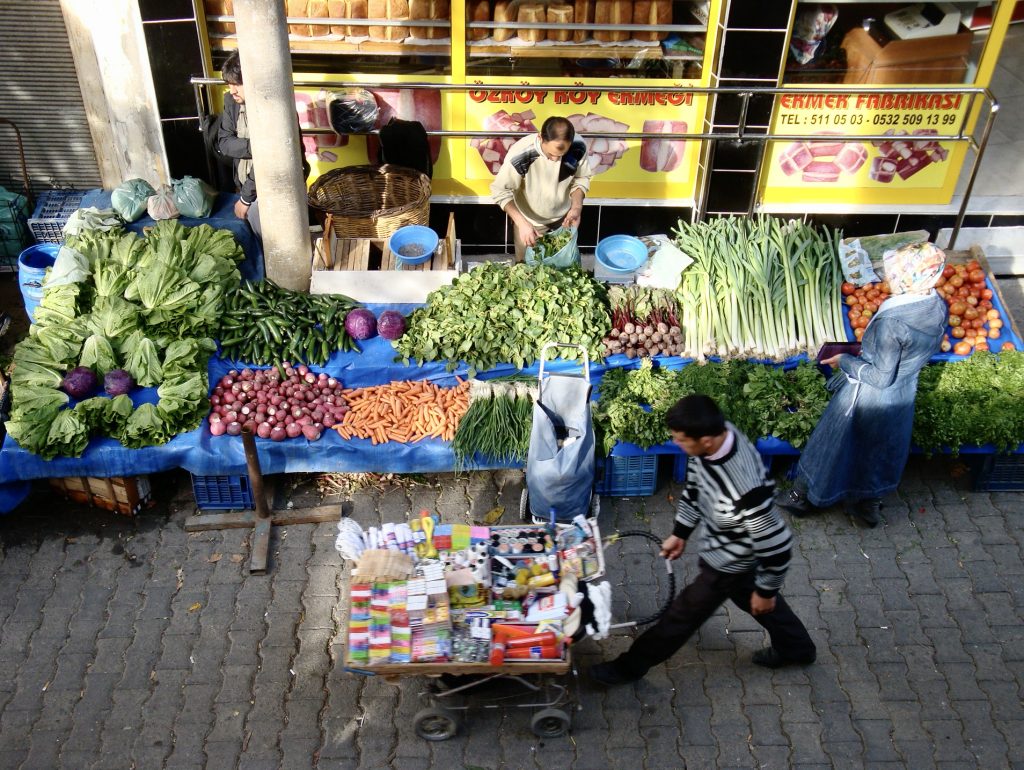“Cotton” Town Population: 65,000
Old name: Tyrrha (Lydian), Tiera (Roman)
Market: Tuesday
Festival: Nevruz (third Sunday of March)
If there was a prize for the most interesting small Turkish town that has somehow managed to miss out on big-time tourism, it would probably have to go to Tire which lies just 30 km inland from Selçuk and Ephesus but gets hardly any visitors other than those who come to shop at its famous Tuesday market.
Tire is a hillside town that dates right back to Hittite times, although most of what there is to see here today springs from the days when it was part of the fiefdom of the Aydınoğlus and from early Ottoman days. In 1402 it was caputured by Timurlane who stayed the winter and used Tire as a base for an assault on Smyrna (İzmir). From the 15th to 18th centuries it was a town important enough to have its own mint and its own fire brigade, where apparently members of ths sultan’s entourage often lived in their retirement. Even today its narrow streets are packed with wonderful old mosques, and with the remains of many old hans and hamams. Even the local library repays a quick look.
It’s especially interesting for what it shows us of the building styles that prevailed in this part of Western Anatolia during the early Ottoman era and during the little known period following the break-up of the Selçuk Sultanate of Rum when it was part of the Aydınoğlu Emirate.
Don’t leave town without:
- grabbing a greasy dinner of Tire köfte, long, thin fingers of meatball
- buying a pair of felt slippers, surely the warmest and comfiest in the world
- admiring the silk known as beledi dokuma still being made on an extraordinary loom in a restored hamam
Around town
Dolmuşes from Selçuk drop visitors off near Tire’s sleepy little museum (closed Mondays) which contains a collection of Roman glass, ancient tombstones and Byzantine crosses, all of it so casually labelled that it is impossible to find out where they came from. In spite of that, it’s still worth pausing to admire an exquisite statuette of Aphrodite and one of her many lovers, and a huge sarcophagus that looks unnervingly like a terracotta submarine.
A new Kent Müzesi (City Museum) dedicated to the town’s more recent history can be found right beside Cumhuriyet Meydanı, the wooded roundabout where buses to İzmir pick up and drop off passengers.
Most people choose to come to Tire on a Tuesday when one of Turkey’s largest street markets insinuates itself into every nook and cranny of the old Tahtakale neighbourhood. Not far from the museum a road is closed off for the market, and this makes a good starting point for touring the older part of the town.
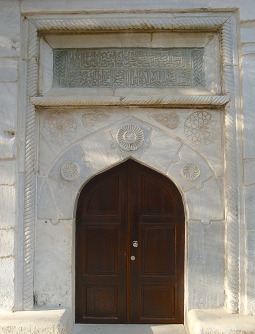 Tomb of Süleyman ŞahIn a small park on the corner stands the tomb of Süleyman Şah, one of the Aydınoğlu dynasty who ruled Tire in the period following the collapse of the Selçuk Sultanate of Rum and who briefly made Tire their capital from 1390 to 1405.
Tomb of Süleyman ŞahIn a small park on the corner stands the tomb of Süleyman Şah, one of the Aydınoğlu dynasty who ruled Tire in the period following the collapse of the Selçuk Sultanate of Rum and who briefly made Tire their capital from 1390 to 1405.
Right next to the park is the neat little Bağdadi Necippaşa Kütüphanesi which dates back to 1827. Normally the library is open during working hours, and it’s worth popping inside to see a collection of more than 2,000 beautiful Ottoman manuscripts carefully preserved in what resembles a wooden library within a library.
A bit further along the road a turning on the right leads to the attractive Yeşil Cami and İmaret (Green Mosque and Soup Kitchen), which is named for the lovely blue-green tiles that decorate its brick minaret. The complex was built in 1442 for Halil Yahsi Bey, a general under the Aydınoğlu ruler Murad II, and incorporated a semahane (ceremony hall) for dervishes to carry out their rituals.
If you leave the mosque grounds from the rear and walk along Karahasan Caddesi it will bring you to the 15th-century Karahasan Cami, set in a pretty little garden. The mosque has a wonderful fluted minaret, rather like the better-known Yivli Minare in Antalya, and the columns of the triple-arched portico that front it reuse old marble capitals from ancient Teira.
In the grounds beside the mosque stands a neglected tomb (presumably of Karahasan – Black Hasan), its dome long since caved in.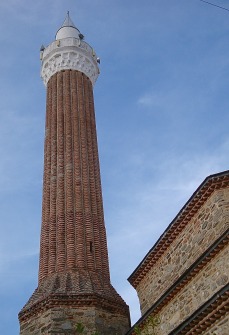 Karahasan Cami
Karahasan Cami
Past the mosque, Karahasan Caddesi climbs up the hillside, passing some wonderful old Ottoman houses and arriving, eventually, at a ruined 14th-century medrese with some lovely old Ottoman tombstones in the graveyard at the front. From here it’s possible to look out over Tire and count the multitude of minarets piercing the sky.
If you walk back down Karahasan Caddesi and turn right onto Ankara Caddesi you come eventually to the Ulu Cami which was probably built for Cüneyt Bey of the Aydınoğlu clan, although in his Seyahatname (Travels) the great 17th-century writer Evliya Çelibi assigned it a later date. This, too, has an imposing minaret with a pattern picked out in brick ringing its base.
From the Ulu Cami it’s easy to step back into the bustle of the market, which completely fills the narrow streets of the normal bazaar area.
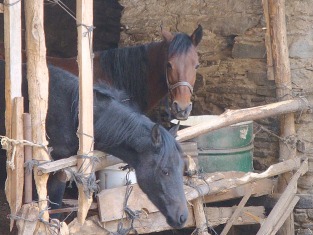 In amongst the bazaar streets it’s worth looking out for the Ali Efe Han, a crumbling old caravanserai which incorporates a lofty old-fashioned tea-house – the sort of place favoured by pigeon fanciers and hobby farmers that it’s hard to believe will ever go the way of a Starbucks.
In amongst the bazaar streets it’s worth looking out for the Ali Efe Han, a crumbling old caravanserai which incorporates a lofty old-fashioned tea-house – the sort of place favoured by pigeon fanciers and hobby farmers that it’s hard to believe will ever go the way of a Starbucks.
Also nearby is a street where it’s still possible to find an old-fashioned tinner (kalaycı), hard at work lining copper cauldrons. Right next door is a shop which specialises in selling instruments made out of gourds. Both shops are set into the side of what was once a vast bedesten (covered bazaar); the entrance is just round the corner and the tinner may lend you the key.
Right in the heart of the bazaar is the Yeni Cami (New Mosque), built in 1597 for Behram Bey, an Ottoman army officer. Of the hospital that used to stand beside it there is no longer any trace, but the mosque retains its delicate brick minaret and a triple portico with newly painted ceilings.
Like the Yeni Cami, the nearby Tahtakale Cami (1401) is set into the slope of the hill so that from one side it has to be approached up steps. The lower part of its minaret is partially concealed so that it used to be nicknamed the ‘mosque whose minaret has no base.’
As you start to walk back down from upper Tire it’s worth looking for the part of the bazaar which specialises in shoes. Tucked into this area is the newly restored Yahsibey Hamamı, which must, in its time, have been a truly magnificent bathhouse.
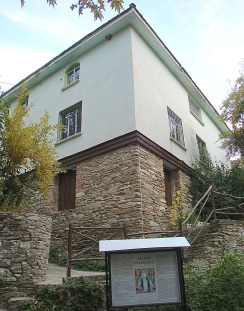 Mosque and church on same siteNear the hamam there is also a section of what was once the 16th-century Kurşunlu Kervansarayı (Leaded Caravanserai), built for Mustafa Lütfü Paşa, a grand vizier to Süleyman the Magnificent. In its heyday this was used by copper traders who slept in the rooms upstairs and stabled their animals below them.
Mosque and church on same siteNear the hamam there is also a section of what was once the 16th-century Kurşunlu Kervansarayı (Leaded Caravanserai), built for Mustafa Lütfü Paşa, a grand vizier to Süleyman the Magnificent. In its heyday this was used by copper traders who slept in the rooms upstairs and stabled their animals below them.
Up the road from the Gülcüoğlu Konakları, a boutique hotel created out of a pair of Ottoman mansions, is a possibly unique mosque that sits immediately above a church (a chapel really) like a duplex apartment block. The answer to the site’s multicultural popularity can be found in the nearby ayazma, or sacred spring, which was shared by Christians and Muslims. It now forms part of the prettily landscaped Derekahve Park.
The fine Yahşı Bey (Yeşil İmaret) Cami, dates back to 1442 and features a pretty and unusual semi-dome arching over the mihrab area. It has been completely restored as has the wonderful 15th-century Yavukluoğlu (Yoğurtluoğlu) complex a little way out of town on the road to Kaplan. With its medreses enclosing a rectangular courtyard, this complex has something of the inward-looking feel of a Western European monastery, although the tower rising above the rooms facing the mosque itself probably served as a muvakkithane, or time-keeper’s house, where the precise times of Islamic prayer could be calculated.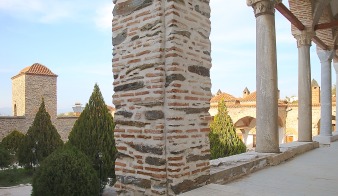 Yavukluoğlu Complex The complex even includes an observatory, this having been a mosque popular with scientists.
Yavukluoğlu Complex The complex even includes an observatory, this having been a mosque popular with scientists.
Tire’s historical monuments are all the more fascinating for being so little known. But if you visit on a Tuesday you may well find your attention equally taken up with the wonderful street market.
Mainly this is a market for locals who come here to shop for fruit and veg, nohut ekmeği (chickpea bread), and other household necessities. As you browse the stalls you will be rubbing shoulders with women from nearby villages who still wear distinctive wraparound maroon and black striped skirts over their leggings.
For visitors, two sections of the market are likely to be of particular interest. The first is the fabric market where it’s sometimes possible to pick up old embroidered towels and tiny knitted Ottoman purses, although prices are hardly bargains.
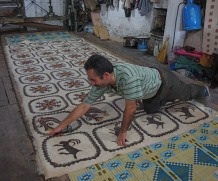 The second is the street where the saddle and felt-makers still ply their trades. While few foreign visitors are likely to want to invest in a saddle, however attractively decorated, the felt shops sell wall hangings, small rugs and seat covers, as well as surprisingly delicate shawls and extremely comfortable slippers that make excellent gifts. The prices are not bad either.
The second is the street where the saddle and felt-makers still ply their trades. While few foreign visitors are likely to want to invest in a saddle, however attractively decorated, the felt shops sell wall hangings, small rugs and seat covers, as well as surprisingly delicate shawls and extremely comfortable slippers that make excellent gifts. The prices are not bad either.
Sleeping
Tire is easily visited on a day trip from Selçuk or İzmir.
Gülcüoğlu Konakları. Tel: 0232-511 0614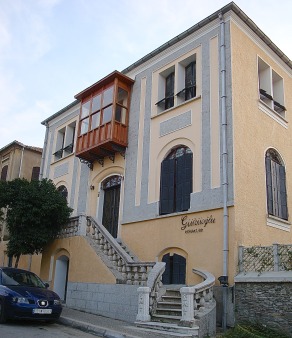
Transport info
There are hourly buses from Selçuk bus station to Tire or you can catch the train from İzmir’s Basmane station.
Day trip destinations
Read more about my visit to Tire: http://www.turkeyfromtheinside.com/blogbloggingaboutturkey/entry/37-the-tradesmen-of-tire.html
